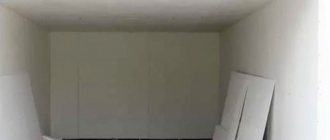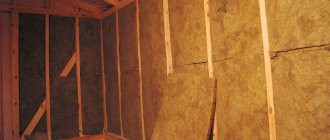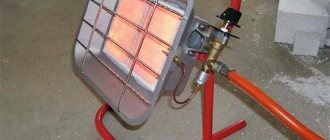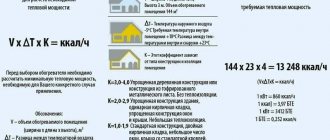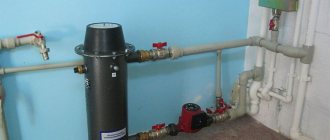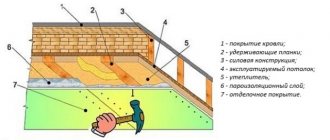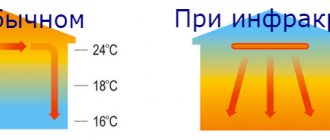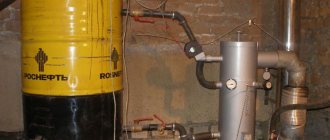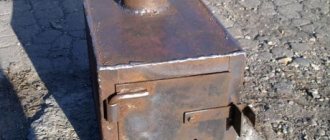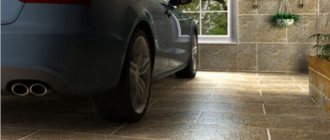A damp and cold garage is not the best place to keep a car. The owner is provided with problems with the technical condition of all its components. Accumulating condensation will damage not only the car body, but also the electrical wiring.
The main percentage of heat is lost through the doorway. The swing steel structure has high thermal conductivity, so insulating garage doors will be a good solution. Dealing with the walls and roof is a little easier than insulating a garage door. To do the work yourself, you will have to study methods and materials.
Comfort and convenience of the garage
Along with its direct purpose, the garage is used as a workshop. During the cold season, even a short stay in the garage will require a lot of willpower. It is convenient to do small repairs in the garage yourself, and good ventilation is essential here. Basement smell, mildew and mold on the walls are not all the troubles. Staying in such a room is life-threatening. Often, openings for supply ventilation are left in the gates. On the topic of how to insulate a garage door, there is a useful video at the end of our article.
Important! Ventilation openings must be left in the thickness of the insulation.
Purchasing a finished product
If you decide to install a factory-made structure in your garage, then the problems of how to insulate the gate will end there. New lift-and-turn and sectional devices already have a layer of polyurethane foam. Even roller shutter types of gates are sometimes insulated, but the possibility of using them for a garage is very doubtful. Narrow aluminum slats will not provide reliable protection against burglary, and their high thermal conductivity makes them unsuitable for our climate. When ordering a gate, a swing system with a wicket would be a good option. It will significantly reduce the percentage of heat loss.
Step-by-step execution of work
In order to insulate a garage door from the inside with polystyrene foam, cotton wool or foam, you will have to perform several stages of work.
And the first of them is preparing the door leaf.
Stage 1: preparation
In particular, preparation involves completely cleaning the metal from rye and paint residues. There are three ways to get rid of corrosion:
- Mechanical. Using a special brush with metal teeth or the same discs and a grinder. The metal is well processed over the entire surface. Especially in areas of rust.
- Chemical. A rust converter can be used here. They cover the entire inner surface of the gate and wait for a reaction.
- Using paint. There are 3-in-1 compositions that simultaneously function as a rust converter, primer and paint. Hammerite behaves especially well in this case.
Advice: it is better to prepare the garage door by first removing it from its hinges and laying it on a flat surface.
Stage 2: waterproofing
Even if you decide to insulate your garage door with plywood, you still need to pre-treat the metal with a waterproofing material. It protects any insulation from moisture and fungus. And most importantly - from losing your airiness.
Roofing felt, bitumen mastic, 2 mm thick isolon or a membrane are used as waterproofing. The waterproofing is applied overlapping so that there are no gaps.
Stage 3: making the sheathing
It is made from thin timber 40x40 mm. It can be a little thicker if the thickness of the insulation is greater. It is important that the slabs or rolls lie flush with the sheathing beams. It is advisable to treat the wood with fire retardants and an antiseptic against burning/rotting.
Slats or beams are attached to the door leaf vertically in increments equal to the width of the insulation (slabs or rolls). To strengthen the structure, you can also make transverse bars of the sheathing. All beams are attached to the metal through and through using screws or self-tapping screws. But first it’s worth marking the places of fastenings and drilling holes in the wood in advance. This is necessary so that the bolt does not split the wood.
Tip: place rubber gaskets under the head of a screw or bolt.
We choose the insulation wisely
The assortment is quite wide. Among the things that can be used to insulate garage doors, the most in demand are:
- Various types of foam plastics;
- Fiber insulation (glass wool, stone wool, basalt wool).
To make a choice, you need to take into account all the pros and cons of the materials.
Styrofoam
Polystyrene foam is a very economical option. The class of foamed polymers is quite diverse. They have a gas-filled structure and vary in type of polymer. Let's consider the types of foam plastics:
- Polystyrene is the most used. They are designated PSB or PSB-S. Extruded polystyrene foam (EPS) - has low hygroscopicity and good fire resistance. Insulating your garage door yourself is one of the best options.
- Polyvinyl chloride or PVC panels. Similar in characteristics to EPSS. International PVC marking. High fire resistance.
- Urea-formaldehyde foam (UFP). Used for voids and cavities. The liquid composition of CFP does not increase in volume after complete drying. Can also be used as garage insulation.
- Polyurethane foam (PPU). It is produced in the form of elastic foam rubber and polyurethane foam. Hard polyurethane foam adheres well to any surface. Good hydro and heat insulator. Fire resistant. Such insulation will be light in weight and suitable for any finish. Polyurethane foam will do an excellent job of thermal insulation of garage doors. A sprayer is used to apply the foam.
Fibrous materials
Among fibrous insulation materials, we immediately exclude stone wool and slag wool. The first is extremely harmful to humans; slag wool will oxidize the metal surface. Glass wool is dangerous to work with, but of all, it has average hygroscopicity. It is this quality that makes the use of cotton wool unsuitable for garages. The accumulation of condensate in a layer of material will reduce its thermal insulation properties. With a vapor barrier film, you can use basalt insulation.
What is the best way to sheathe door panels?
At the end of the last century, it was customary to insulate garage doors from the inside with thick plywood, boards and similar timber. Fastening was carried out in the simplest way: bolts were welded to a metal panel, a plywood sheet was placed on them and screwed with nuts.
Sheathing with regular plywood
Gates insulated in this way did not retain heat well, but they gained a lot of weight - it became harder to open the doors. Often the canvases sagged and became jammed in the lower porch. Nowadays, instead of ineffective wooden cladding, modern thermal insulation materials are used:
- mineral wool based on basalt or glass fibers;
- polymer products in the form of plates - polystyrene foam, extruded polystyrene foam;
- foamed polyethylene with a layer of foil, produced in rolls;
- polyurethane foam.
Note. We deliberately do not mention other modern insulators, for example, ecowool. Insulating a garage with these materials is too expensive and not economically feasible.
Any mineral wool is unsuitable for thermal insulation of garage doors for the following reasons:
- Hinged sashes experience dynamic and impact loads. Cheap, low-density rolled wool quickly sags and exposes the metal surface, as happened in the photo.
In one section, the mineral wool insulation was knocked down
- The denser version of the insulator offered in slabs is much more expensive. In addition, the insulation will noticeably make the gate heavier.
- Mineral wool is permeable to water vapor, but metal is not. To prevent condensation from forming at the junction of two materials, you will have to install an additional vapor barrier layer.
Polymers that work best with metal are polystyrene foam and extruded polystyrene foam (aka Penoplex). The insulators are lightweight, practically do not allow steam to pass through and are easily attached to the gate. Foam plastic is the cheapest insulation; the price of Penoplex is comparable to the cost of slab basalt wool.
Foil polyethylene foam is too thin (up to 12 mm thick) to serve as thermal insulation for iron gates. It is recommended to use the building material as an additional layer to the main insulation. Let's give an example of such a combination: foam plastic 25 kg/m³ 40 mm thick plus rolled Penofol 6-8 mm.
Effective thermal insulation made of polyurethane foam is the best solution for insulating walls, ceilings and gates of iron garages. The material in the form of foam is applied by spraying using highly specialized equipment. If you are interested in this method, we recommend watching the introductory video:
The process of insulating a garage from the inside
To insulate your garage door you will need the following tools:
- Electric drill;
- Drills for wood and metal;
- Hacksaw or jigsaw for wood;
- Metal brush or drill attachment (brush);
- Screwdriver.
Also don’t forget about a tape measure, a paint brush, a hammer, a corner and a ruler, a sharp knife, a core, sandpaper and clamps. A clamp is a means for clamping parts. They will be convenient for attracting slats to the gate frame.
The order of work will depend on the insulation and type of construction.
Preparing the sashes
Cleaning
Remove old paint, rust and all dirt. This can be done conveniently and quickly using a power tool with an attachment.
Padding
The applied primer will protect the metal from corrosion. To work, take a wide paint brush. Anti-corrosion primer is applied in two layers. One across and the other along the surface.
Eliminating gaps between the frame and the canvas
Use a rubber seal. It will not interfere with the operation of the mechanism and will close unnecessary holes. Next, we will look at how to insulate garage doors from the inside.
We insulate swing gates with foam plastic.
Swing gates are durable, reliable and easy to use. The system consists of two steel sashes welded onto a frame made of a profile pipe or angle. Sometimes corrugated sheeting is used, but a steel sheet 2-3 mm thick is stronger.
It is good when the insulation of swing gates is carried out by their manufacturer. Otherwise, you can insulate your garage door yourself. After choosing the material, you should calculate how much is required. You also need to decide on the finish on top of the insulation. The final version with different types of gate cladding can be seen in the video. There are many options for covering garage doors.
Types of facing materials:
- Lining;
- Profiled sheeting;
- Fiberboard or MDF panels;
- Waterproof plywood;
- OSB or OSB boards.
Experience has shown that the latter are more suitable for cladding. OSB boards are plates made from glued and pressed sawdust and wood chips. If you look at the photo of the product, you can see its composition of several layers. The layers have different arrangements, which gives the sheets special strength and flexibility. This finish is easy to process, has low vapor permeability and is very economical.
How to properly insulate a garage door with your own hands
Having completed the preparatory activities, they begin the main process. The insulation technology depends on the material used. For this reason, it is worth considering different, most common options.
How to insulate garage doors with polystyrene foam
Foam plastic is considered the cheapest and easiest to install. The slabs are cut to such sizes that the fragments fit tightly between the sheathing elements. Foam is applied to one side of the foam. Other adhesives can be used. However, foam is still needed to blow in cracks, so it is more advisable to use only glue. The foam-treated fragment is inserted inside the sheathing cell and pressed against the surface of the sash. This procedure is continued until all the gates are covered. To prevent the slabs from falling off, they are temporarily fixed with wire, stretched over nails driven into the sheathing beams.
It is optimal to use foam for gluing polystyrene foam.
While the slabs are being glued, all cracks and joints are covered with foam. After hardening, the protruding excess is cut off with a knife. The tensioned fixing wire is removed. The gate is ready. To protect the foam from damage, plywood, fiberboard or lining is attached to the sheathing.
How to properly insulate a garage door with penoplex
The technology for using penoplex is similar to working with polystyrene foam. However, there are a number of nuances. The slabs are glued in the same way, but it is not necessary to use lathing. Penoplex is not fragile, much stronger than its counterpart. It is important to choose a reliable adhesive so that the insulation will adhere well.
Penoplex can be glued directly to the garage door without sheathing
Another nuance is the presence of locking joints for slabs with a thickness of more than 20 mm. The locks provide a strong joint that does not require foaming. It will be possible to stick foil tape along the seams to enhance the tightness.
How to insulate garage doors with foam
Polyurethane foam insulation in the form of conventional polyurethane foam is also suitable for garage doors, but you will need many cylinders. First you need to calculate the approximate consumption by studying the instructions. The amount of expansion will be written on the balloon. You need to take it in reserve. All the foam does not always come out of the can. Sometimes the expansion coefficient does not match, or other nuances arise.
The foam is applied vertically from bottom to top
It is optimal to carry out foaming with a pistol nozzle. The foam is applied in thin vertical stripes from bottom to top. After foaming the entire surface, leave it to harden for a day. The excess is cut off with a knife and the top is covered with finishing.
How to insulate iron gates in a garage with mineral wool
When choosing mineral wool for work, preference is given to basalt slabs. You should immediately discard rolled material. The slabs are tightly inserted between the sheathing elements. Joints and cracks are filled with foam. Waterproofing must be laid between the insulation and the metal surface. It will protect the steel from corrosion, and the mineral wool from being saturated with condensate.
Mineral wool is used only in the form of slabs
The basalt slabs are covered with a vapor barrier on top. The film is stapled to the sheathing. Only after installing the vapor barrier can the finishing be applied.
Insulating garage doors with tarpaulins
You can quickly organize the insulation of the gate with a tarpaulin curtain. Any rubberized fabric, the size of which corresponds to the entrance opening, will do. The curtain is hung so that it moves to the side so that the car can freely leave the garage.
The curtain is optimally used as temporary thermal insulation
The disadvantage of this method of insulation is inconvenience. To enter the garage, the curtain will have to be constantly moved and returned to its place. If you cut out a passage, there will be no thermal insulation from it. In addition, condensation accumulates between the curtain and the gate due to temperature differences. The metal begins to rust quickly.
Insulating garage door cracks with a fire hose
Any gate has gaps. An old fire hose will help get rid of them. It is secured with bolts through a metal plate lining around the entire perimeter.
The fire hose is screwed around the entire perimeter of the gate
A fire hose will even help insulate the bottom of the garage door, eliminating the gap on the threshold. When opening the doors, it will bend easily. But the sleeve will quickly wear off due to frequent opening of the gate.
Insulating a garage from the inside with construction foam
Another method of insulating garage doors with your own hands is polyurethane foam. Of the ways you can insulate garage doors with your own hands, this is the easiest way.
- Polyurethane foam in cylinders (consumption of 5 cylinders per 7m2).
- Spray the foam in an even layer (cut off excess material after drying with a sharp knife)
- Decorative finishing (the covering can be chipboard, lining or any other material).
The advantages of insulating garage doors with your own hands using foam are that the material penetrates even into small cracks. This will also strengthen the entire gate structure.
The safety of your premises and vehicle in proper condition depends on the quality of garage door insulation. Safety also depends on choosing a reliable garage lock.
A garage is a real home for a car, protecting the car from the negative effects of rain, snow, moisture and dirt. Here you can repair your car, store spare parts, tools or things you don’t need in your apartment. In order not to depend on weather conditions and the time of year, many owners strive to insulate their garage doors, because they are the main cause of heat loss. Recommendations and tips for insulating garage doors with your own hands can be found below.
Ways to insulate garage doors
In general terms, the technology for insulating any building involves covering structural elements with thermal insulation. The material can be fixed outside and inside the room. Garage doors are similarly no exception. However, here you need to think about which option is optimal.
In the video, insulating a garage door:
Insulating garage doors from the inside
In most cases, I insulate the gate from the inside. The popularity is due to many advantages:
- The insulation is protected from precipitation, sunlight, and vandalism. There is no need to attach reliable finishing cladding. From the inside, the thermal insulation can simply be covered with film, fiberboard or tarpaulin.
- The aesthetic exterior of the garage does not suffer.
- Most garage doors are welded into a frame of angles and sheet metal. On the inside, the side shelves of the frame form a kind of niche where it is convenient to attach the insulation.
It is more convenient to attach the insulation from the inside of the gate
Internal insulation involves stripping metal doors of paint and rust and treating them with a primer. If the selected material requires the creation of sheathing, then the elements are attached directly to the sashes. Later the final cladding will be fixed on them.
Insulating garage doors from the outside
Almost no one insulates garage doors from the outside. The action is considered unreasonable. Firstly, the steel doors themselves are a vandal-proof structure. If you attach thermal insulation to them, you will need to sheathe the top with metal. The gate will double its mass. Under heavy weight, the doors are more difficult to open, the hinges may break, or the entire frame may separate from the building. Secondly, the gate will increase in thickness and will protrude beyond the boundaries of the garage façade. This design does not look aesthetically pleasing.
Thermal insulation is very rarely attached to garage doors from the outside.
As additional insulation, the outside of the garage door can be painted with a special paint that has heat-saving properties. From the street side, blow foam over all the gaps formed between the frame and the ends of the walls of the doorway.
What does insulating garage doors solve?
Of course, there are many reasons to insulate the gate; we will list only the most obvious:
Insulating garage doors solves a number of reasons for both summer and winter. The photo shows polyurethane foam insulation.
- In summer, the metal sheets of the gate, heating up in the sun, heat the air in the garage so much that it becomes impossible to stay there. And in winter, frost penetrates inside through cracks, lowering the temperature to street temperature. Repairing in such conditions is simply harmful to health.
- If heaters are used in cold weather, then insulation of the garage door is necessary to maintain the temperature and conserve heat and electricity.
- In a properly insulated garage there will be lower humidity and less condensation, which leads to corrosion of the car body. The microclimate of the room becomes softer and devoid of temperature changes.
Features of insulation of sectional doors
There are gates that already contain insulating material. They are called sectional. They are an outer layer of steel with polyurethane inside.
Most often, such gates do not require the installation of additional insulation elements. Such gates must be ordered from a workshop.
There are many different ways to insulate gates. You need to choose quality material that fits your budget.
Video: Garage door insulation option
Video: Another insulation option
Proper insulation is the key to success
There is a wide range of insulation products for garage doors on the market. How to understand all this diversity? It is best to thoroughly understand the main types, because not everyone is suitable for your case.
- Foams are synthetic foam materials based on polymers.
Foam plastic is an easy-to-use material
Polystyrene foam, perhaps the most famous type, looks like connected white balls. Excellent for insulating gates due to its lightness, minimal hygroscopicity, strength and fire resistance. Sometimes called expanded polystyrene.
Urea-formaldehyde foam is also often used in heat and sound insulation. It has the property of not swelling when hardened. Also suitable as insulation for garage doors.
Sprayed polyurethane foam is an effective thermal insulator for gates
Polyurethane foam is divided into two types. The first is ordinary foam rubber, and the second is polyurethane foam. In thermal insulation, the latter option is used. The foam has excellent thermal conductivity properties and even serves as a waterproofing agent. Sprayed onto the surface, filling cavities. An excellent material, however, the cost of application may be a reason not to choose this material.
- Mineral wool - a material used in construction, has three subtypes: glass wool, slag wool and stone wool. The use of mineral wool is limited due to its hygroscopicity.
Glass wool consists of tiny glass particles and has low thermal conductivity: 0.03 - 0.05 W/m*K. Caution should be used when working with this material.
Slag wool is produced from metallurgical residues (slag). The thermal insulation of the material is slightly worse - 0.04-0.05 W/m*K, which does not reduce its popularity in construction, but it will not work for sheathing garage doors - the material does not “get along” well with steel.
Stone wool is made from rocks. Thermal conductivity - 0.03−0.04 W/m*K. It is also not suitable for insulating garage doors, since when heated the material releases toxic substances.
Second stage: insulation using various materials
Foam insulation
- When using PSB foam, you must also use waterproofing methods. Or you can sheathe it with EPS, which does not absorb moisture. Such panels are more expensive, but do not require insulation. To attach the foam to the surface of the gate you need:
Scheme for insulating garage doors with foam plastic
- It is necessary to cut sheets of foam plastic, measuring 2-3 mm larger than the size of the lathing cells, this is done for a tighter fit of the insulation. Ideally, the number of joints between sheets should be minimal.
- The insulation can be attached using polyurethane foam; it is better if it does not increase much in volume when it dries. Foam is applied to the back side of the foam along the edges and in the middle and the sheet is pressed as tightly as possible against the gate. Within half an hour, a more precise adjustment of the insulation is performed.
- When the sheets are attached to the gate, all that remains is to fill the joints with foam. After the polyurethane foam has dried, you need to get rid of the protruding excess, which can be easily done with a regular knife.
Insulation with mineral wool
Insulation of garage doors with mineral wool
The use of mineral wool when insulating garage doors is quite acceptable. But in comparison with the technology of fastening polystyrene foam, mineral wool is more demanding in terms of surface preparation. Thus, due to the hygroscopicity of the material, it is necessary to treat steel surfaces with bitumen mastic or isolon.
After waterproofing the sashes, you can begin cutting the mineral wool into pieces of the required size. You should achieve the tightest possible fit of the insulation fragments to the sheathing and to each other, since mineral wool has a tendency to caking. Next, a vapor barrier film is attached over the insulation so that the inside is not exposed to moisture.
Insulation with polyurethane foam
Insulating garage doors with polyurethane foam is the fastest way
In this case, you should also take care of the lathing, as it will be needed for cladding the gate. To apply polyurethane foam, a special spraying technique is used, so you need to find a company that provides application services. Before covering with this type of insulation, you need to seal those holes and parts of the gate into which foam is undesirable. During the application process itself, it is necessary to protect the mucous membranes from harmful vapors of polyurethane foam in its wet state. When the insulation has completely hardened, it will become harmless to humans. Some benefits of using polyurethane foam:
- Thermal conductivity coefficient is 0.019–0.035 W/m*K. This is an order of magnitude better than mineral wool or polystyrene foam.
- Excellent cavity filling.
- Durability - service life of about 60 years.
Materials for sealing and insulating gaps and cracks
The easiest way is to cover the cracks with foam. But as the foam expands, it can deform weak masonry or plaster. In addition, the service life of such sealing is a maximum of five years, no more.
You can treat cracks that are previously insulated with other materials with polyurethane foam:
- polystyrene foam is the most affordable and accessible material. Minus - there is no guarantee that all voids will be filled with insulation;
- sprayed penoizol or polyurethane foam is a durable, hermetically sealed protective film, literally a monolith. But, an apparatus for applying insulation is required; such insulation is not cheap;
- mineral wool is the best option for any material of walls and gate leaves. Mineral wool does not burn and reliably fills all voids in cracks.
An important rule is that when insulating with mineral wool, it is imperative to reliably seal the cracks with plaster or water-repellent mastic, since mineral wool loses its properties when wet.
Another modern method of thermal insulation is paints with a warming effect, fire-resistant. This paint contains polymers and ceramics and creates a reliable thermal insulation film. You need to apply two layers of this paint, waiting until the first layer has completely dried.
Video: a budget way to insulate garage doors
Insulating a garage door is a difficult but necessary process, because being in the room should be comfortable for both the person and his car. The most optimal method of insulation today is polyurethane foam insulation. This is the most effective material in terms of its characteristics. At the same time, it is much more convenient to improve the microclimate in the garage with your own hands using polystyrene foam. What exactly to use and whether to do cladding is decided only by the owner. We hope this article was useful to you.
Large spaces between the bottom of the gate and the ground in a country house can serve as an opening for wild or neighboring animals. Therefore, many owners of summer cottages and country houses have a question about how to close the gap under the gate.
Gap under the bottom of the sashes
Gaps can form not only under large gates in suburban areas. Therefore, before deciding how to close the bottom of the gate from animals, neighbors’ cats and dogs, as well as bad weather, you need to understand the reason for the gap.
A selection of video lessons on the topic
Technology for insulating old garage doors:
How to seal cracks on garage doors:
Internal lining of heated garage doors:
Insulating the entrance opening and garage door yourself should not cause difficulties. This should not be considered an excess; it is safer to store the car in a warm room without condensation; rust will not affect it. To do this, it is enough to insulate the garage doors with penoplex or mineral wool, and also close the cracks with rubber or silicone sealant. And as an additional barrier to cold air, you can hang a canvas curtain.
Describe your question in as much detail as possible and our expert will answer it
I want to share how I insulated the gate around the perimeter. I attached a corner to the slopes and put a car door seal on it. Now I’m racking my brains on how to seal the gap between the gate and the threshold, there’s a breeze coming from there. Tell me, how did you solve the problem?
Why do gaps appear between the gate and the ground?
Heavy iron doors in garages are also prone to the formation of gaps that need to be sealed to prevent cold air from entering the room in winter and hot air from entering the room in summer.
The clearance under the gate at the dacha appears as a result of the selected landscape for the development.
When installing swing gates on an uneven surface, even forged gates with a slight slope, a gap will form.
At different times of the year, soil movement occurs if the entrance is not paved. And in winter, snowdrifts will prevent the doors from opening wide open. This is the second reason for leaving a gap at the bottom when building a gate.
Also, under the sliding gate, a gap will appear between the bottom of the gate and the rails. This distance is maintained so that the doors can easily move in different directions without touching either the ground or the rail.
The photo shows a timber impregnated with an antiseptic to hide the gap from animals.
Why do you need a seal?
No matter what kind of garage door you install, there will be gaps in it. It doesn’t matter whether they are folding, hinged, sliding, or the like. Cold penetrates through the cracks that form during the cold season. To level out heat loss, the right solution would be to seal the valves. If you do this job well, you can completely eliminate the possibility of cold air entering through the door cracks.
Today you can come across the opinion that only metal products should be sealed. However, if you have a wooden gate, they also need it.
At what stage should a garage door seal be installed? In most cases, this is done at the construction stage, namely when installing gates. If these works were not completed, then the seal can be fixed after a while. Let us immediately note that doing this work is quite simple. First, let's look at what material is best to use for this.
Methods for removing gaps under gate leaves in suburban areas
If you firmly attach any metal structure to the bottom of the gate, then it will be difficult to close it. At the same time, if you install a non-rigid structure, stray animals will still get through.
There are several methods for removing the gap under the animal gate with your own hands:
- Using a chain-link mesh. It will close any gaps from cats, dogs and smaller animals: rats, mice. Anyone can tighten such a mesh without outside help.
- You can close the gap using a small blade made of loam or clay on the side in which they do not open. This option is suitable for dacha plots.
- For owners of private suburban areas, it is recommended to level the space and pave it. If the gap still remains large, then you can install the conveyor belt at the bottom of the sash using self-tapping screws. The same method is recommended for closing the gap at sliding gates.
- You can put a speed bump. It looks nice and your pet won't get hurt if they try to get through the barrier.
- A beam laid along the gate will also become an obstacle for many animals. It is necessary to soak it well with an antiseptic so that it does not rot from dampness in the spring and autumn seasons.
- In private homes and summer cottages, you can use a regular wooden board to close the gap. When leaving, it should be removed so that the gate can be easily opened.
The photo shows a speed bump in the form of a barrier for animals.
Sliding gates in a private house
Not only owners of suburban areas, but also garage owners are thinking about how to remove cracks under gate leaves.
Which gates need insulation?
Most often, garage doors are made in the form of a swing structure that needs to be insulated. A corner or profile pipes are used as the gate frame, to which a sheet of metal is attached. Since steel conducts heat very well, the lack of thermal insulation does not in any way prevent it from leaking out of the garage. Sometimes swing gates are equipped with a wicket gate, which significantly reduces heat loss if the garage is often opened and closed.
Today, the most common gate designs are overhead and sectional. The canvas is made of sheet metal on the outside and foamed polyurethane on the inside. Such a design is already equipped with the necessary thermal insulation from the factory and is able to effectively retain heat.
We recommend: Thermofor stoves for baths and saunas: rating of popular models
Sometimes up and over gates are made independently. This design, like the swing one, does not have any insulation, since the material is bare metal. If the garage is equipped with roller gates, then their design simply does not allow for insulation.
Methods for getting rid of holes and cracks in the garage
If the question is how to close the gate from the penetration of cold, animals or small rodents in the garage, then you can use various seals. Two types are used:
Before installing the seals, it is recommended to degrease the lower part of the gate leaves and the lower part of the iron or wooden frame to which they are attached. This is done so that the seal does not come off later.
To use silicone sealant, work is carried out in several stages:
- Open the gate leaves in different directions until they stop.
- Remove dirt from the gate leaves and frames, degrease the surface on which the silicone will be placed.
- Apply tape around the perimeter.
- Apply a layer of sealant around the perimeter of the box. It is best to do the work with a mounting gun. The consumption of sealant will decrease significantly.
- Close the gate and wait for the silicone to harden.
- If there are any gaps left, you should continue filling them with silicone.
For large gaps, it is recommended to seal the gate in two passes.
Polyurethane foam is also used to seal the gate. However, its shelf life is short. Due to constant temperature changes, it will quickly lose its properties. If the garage owner decides to use foam for sealing, then experts recommend plastering the opening between the wall and the gate.
If the distance between the doors and the frame is sealed, it is better to use rubber seals.
How to get rid of cracks under a fence
Some time after the construction of the fence, cracks may appear under it. Such holes are usually made by pets that roam freely around the site. For example, dogs often do digging. Ground sliding is also possible.
As a result, erosion appears and the space between the ground and the fence is exposed.
To prevent gaps from appearing, it is recommended to do the following during the construction stage:
- raise the foundation. Even on an uneven area, the foundation can help adjust the fence to one line;
- make embankments. But this is a labor-intensive and expensive method. The fact is that it is necessary to fill the area where the fence will be with soil. Then piles are driven in, which will hold the soil from washing away.
If the owner of the site has done nothing to prevent the soil under the fence from eroding, then actions should be taken during operation to prevent further erosion of the soil.
The photo shows a mound of soil covering the gap.
When the fence is already in place, the owner should:
- Fill the gaps with soil. Small cracks are filled with earth and over time overgrown with grass, the roots of which will prevent them from being washed out. However, animals will be able to dig.
- Another option is crushed stone. Make a small groove along the fence outside the site and pour crushed stone into it exactly to the place where the lower edge of the fence begins. This will protect against the penetration of forest animals. Foxes, for example, love to dig tunnels, but a pile of rubble can stop them. They will not be able to break through a dense mound of stones.
- It is recommended to hide the cracks with wood. It is necessary to cut the boards to the required width and length. After this, you should cover the lower part with bitumen, and the upper part with an antiseptic or other protective solution so that the wood does not rot from dampness. Then the upper part should be attached to the lower edge of the fence, and the lower part should preferably be dug into the ground. This way, no cat or dog will be able to crawl through the boards.
Additional options
You can close the opening with a sheet of slate. But still, this is an ugly material that will look unaesthetic. This type of protection is most often used for temporary barriers.
As with closing the gap between the gate leaves, a chain-link mesh will help. One end of it must be secured to the fence, and the other must be dug into the ground.
You can use corrugated sheets. It also needs to be attached to the lower edge of the fence using self-tapping screws. The part that is on the ground must be carefully buried.
Bricks or stones will help to bridge the gaps. If you carefully lay them out along the fence, they will look like the original decor as a continuation of the foundation.
Suitable for planting hedges and shrubs.
However, if the owner has small pets - cats or dogs, which often crawl under the fence, then they can cause damage to themselves. Therefore, in the latter case, a hedge is not recommended.
